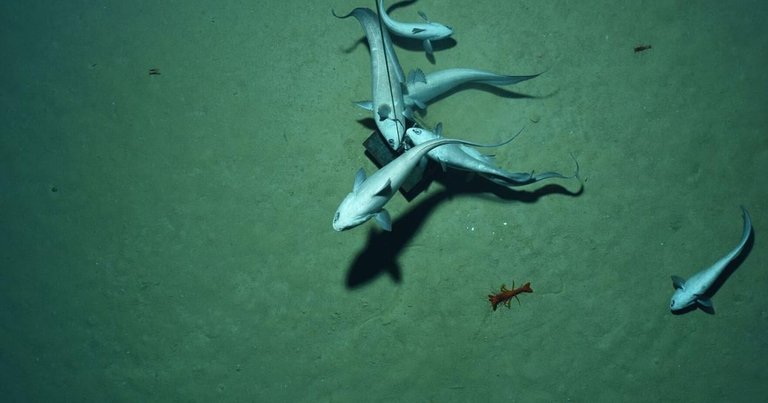
Source
Oxygen is one of the essential elements for life to proliferate on our planet. Historically, it was believed that this oxygen came from stromatolites, microbial mats formed by communities of cyanobacteria, which were capable of carrying out photosynthesis and releasing oxygen into the atmosphere over millions of years.
El oxígeno es uno de los elementos imprescindibles para que pueda proliferar la vida en nuestro planeta, históricamente se creía que este oxígeno provenía de los estromatolitos, tapices microbianos formados por comunidades de cianobacterias, que eran capaces de realizar la fotosíntesis y liberar oxígeno a la atmósfera a lo largo de millones de años.
However, a recent discovery calls this theory into question. Although stromatolites were undoubtedly important for the early oxygenation of the Earth, we now know that they were not the only source of oxygen but that there is also "dark oxygen", produced in the deep ocean through abiotic electrolysis.
Sin embargo, un reciente descubrimiento pone en tela de juicio esta teoría. Aunque los estromatolitos sin duda fueron importantes para la oxigenación temprana de la Tierra, ahora sabemos que no eran la única fuente de oxígeno sino que también existe el "oxígeno oscuro", producido en las profundidades del océano mediante electrólisis abiótica.

Source
Abiotic electrolysis is a process in which the chemical energy of minerals present on the seabed, mainly polymetallic nodules, is used to separate oxygen from seawater. This reaction occurs through complex interactions between metals, rocks and water, without the need for sunlight or living organisms.
La electrólisis abiótica es un proceso en el que la energía química de los minerales presentes en el fondo marino, principalmente nódulos polimetálicos, se utiliza para separar el oxígeno del agua de mar. Esta reacción ocurre a través de interacciones complejas entre los metales, las rocas y el agua, sin necesidad de luz solar ni de organismos vivos.
Dark oxygen has been found mainly in polymetallic nodules, which are concentrations of minerals that are dispersed on the seabed, at depths between 3,000 and 6,000 meters and that are formed over millions of years from the precipitation of metals around materials. such as animal shells or shark teeth.
El oxígeno oscuro se ha encontrado principalmente en nódulos polimetálicos, que son concentraciones de minerales que se encuentran dispersas por el fondo marino, a profundidades entre 3.000 y 6.000 metros y que se forman durante millones de años a partir de la precipitación de metales alrededor de materiales como conchas de animales o dientes de tiburón.

Source
The scientists apparently discovered that these individual polymetallic nodules produced voltages of up to 0.95 V, which implies that, if we group them as batteries in series, they can easily reach the 1.5 V needed to separate oxygen from water in an electrolysis reaction without the need of living beings.
Según parece los científicos descubrieron que estos nódulos polimetálicos individuales producían voltajes de hasta 0,95 V, lo que implica que, si las agrupamos como baterías en serie, pueden alcanzar fácilmente los 1,5 V que se necesitan para poder separar el oxígeno del agua en una reacción de electrólisis sin necesidad de los seres vivos.
The reason this discovery of dark oxygen is important is that it challenges our current understanding of the oxygen cycle on Earth and opens up new possibilities about the origin of life and forces experts to rethink their theories. It is the good thing about science and what differentiates it from religion, that everything can be questioned.
La razón por la que este descubrimiento del oxígeno oscuro es importante radica en que cuestiona nuestra comprensión actual del ciclo del oxígeno en la Tierra y abre nuevas posibilidades sobre el origen de la vida y obliga a los expertos a repensar sus teorías. Es lo bueno que tiene la ciencia y que la diferencia de la religión, que todo se puede cuestionar.
More information/Más información
https://www.firstpost.com/explainers/what-is-dark-oxygen-discovered-on-deep-ocean-floor-leaving-scientists-perplexed-13796432.html#:~:text=Researchers%20have%20found%20that%20metallic,and%20the%20role%20of%20photosynthesis.
Pretty scary stuff man. The discovery really shifts our understanding of how Earth’s oxygen cycle works. Perhaps it can lead to new breakthroughs for us
Maybe it also can be useful to look for live in exoplanets.
Absolutely brother, that would be a great thing for us
When I read the article on this yesterday I found it fascinating. The polymetallic nodules have miners salivating at the thought of being able to harvest them. This discovery will surely protect them since they are essential to life in the deep depths of the oceans. It's not quite cold fusion but it's remarkable that oxygen is being produced in the sea depths around the world. Great post!
!PiZZA
Well I am still so sure that this theory will certainly be evaluated by a whole lot of people whether it is true or not. Let's see how it is